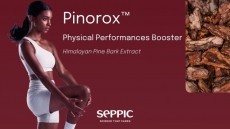Study reveals impact of exercise on gut microbiome

Previous research has demonstrated that exercise is capable of modulating the composition of the gut microbiome. However, these studies have demonstrated different results, strongly dependent on other variables such as BMI status, age range and diet. Studies performed on athletes have also demonstrated varied results which are associated with lifestyle factors including diet, training level, and gender.
In order to improve recommendations in clinical practice, especially for sedentary people, the authors of the current study therefore argued it is important to analyse exercise effects on the microbiome in a more controlled scenario.
The current study was a controlled and randomised study that investigated the effect of a 10-week period of aerobic exercise on the gut bacteria composition of apparently healthy and sedentary young men (20-45 years). The researchers hypothesised that 10 weeks of exercise training would be efficient at improving aerobic fitness (VO2peak) and at modifying bacterial taxa diversity and abundances.
This is the first controlled and randomised study design in a homogenous population with an aerobic exercise intervention capable of promoting significant cardiorespiratory improvements without changing gut-affecting variables, such as body composition, food habits or metabolic parameters.
The study
Questionnaires were applied in order to evaluate inclusion and exclusion criteria. Cardiorespiratory fitness was determined by an incremental maximum test performed in cycle ergometers.
After the baseline measurements, eligible participants were matched for age, VO2peak and BMI, and then randomly assigned into two groups, Exercise Group (EG) or Control Group (CG). All training sessions were carried out on a cycle ergometer. Three supervised training sessions per week on non-consecutive days, lasting 50 min each, were performed over 10 weeks.
The exercise protocol was designed to improve the cardiorespiratory fitness of previously sedentary men over a sufficient time period to affect gut bacteria composition.
Food habits were evaluated from a 48 h food record, a food frequency questionnaire (FFQ) and a three-day food record. The 48 h food record was collected during week 1 (Pre) in order to analyse total energy intake, macronutrients, fiber, cholesterol and water, and was also important for reproducing the same diet during the 48 h prior to stool collection during week 12 (Post). The FFQ was applied at the baseline to evaluate food groups consumption over the six months prior to the trial. The three-day food record was collected during week five in order to evaluate the maintenance of food habits.
Body composition assessments were undertaken at the Pre and Post interventions. Participants provided a stool sample at week 1 and Post intervention. Blood samples were also taken to measure fasting glucose, total cholesterol, high density lipoprotein-cholesterol (HDL-c), low density lipoprotein-cholesterol (LDL-c) and triglycerides.
Results
The resulting data revealed that EG participants demonstrated marked improvements in cardiorespiratory fitness without changes in other gut bacteria-affecting variables.
Exercise did not promote clustering based on diversity indices, although significant variations in an unclassified genus from Clostridiales order and in Streptococcus genus were observed. Moreover, α-diversity was correlated with VO2peak and BMI. Roseburia, Sutterella and Odoribacter genera were associated with VO2peak, while Desulfovibrio and Faecalibacterium genera were associated with body composition.
Microbiome analyses revealed a median reduction of 47.67% in the Proteobacteria phylum of EG subjects, which was not observed in the CG.The authors note: "This observation is relevant since the pathogenicity of a microorganism can be linked to balance among microbes and their interaction with the host, along with its own abundance.
"In congruence with our perspective, Castellanos et al. identified key bacteria driving the transition of a sedentary to an active lifestyle and vice versa independent of bacterial abundances. The authors highlighted that these two conditions involved a reorganization of an unclassified genus from Clostridiales order, unclassified taxa from Streptococcus genus and species from Sutterella, Roseburia and Odoribacter genera, all which is in accordance with our findings.
"In human gut microbiota, Clostridiales order is composed of a high variety of commensals and opportunistic species while Streptococcus genus contains a probiotic species named S. thermophilus and commensal species such as S. salivarius and S. vestibularis. In particular, this latter genus is involved in urea metabolism and lactic acid production, and its metabolites may favor a pH environment that promotes commensal bacteria survival.
"In agreement with our discussion, several authors have suggested that Clostridia and Streptococcus may be potential drivers of population dynamics in the intestine, capable of influencing microorganism interactions and gut homeostasis. Moreover, a recent observational study by Galle et al. found both Clostridia taxa and Streptococcus to be abundant among different BMI and physical activity levels, which highlights the importance of these bacteria in the gut ecosystem."
The researchers also found the VO2peak from EG subjects was positively associated with Alpha diversity indices, as has also been observed in previous studies.
Positive associations were also observed between VO2peak and the relative abundances of Roseburia, Odoribacter and Sutterella. Bacteria from Roseburia genus are known to produce short-chain fatty acids and may selectively favor key members of the gut microbiota. On the other hand, Odoribacter and Sutterella genera are often associated with disease conditions; although one study with a polyphenol intervention in healthy adults showed an increase of Sutterella.
In summary, these key bacteria seem to be associated with antioxidant defenses and thus may be responsive to exercise training effects.
Although EG subjects’ BMI, food habits or blood parameters did not significantly change after 10 weeks of exercise training, it was possible to observe a tendency towards losing body fat and gaining free fat mass as an effect of exercise, which did not occur with CG.
The researchers argue the mutual influence between both gut bacteria diversity and genus and body composition on the EG subjects may reflect the energy metabolism adaptations caused by exercise.
The report states: "Moreover, Faecalibacterium genus and body composition were correlated, and this genus has been suggested as a biomarker for obesity and inflammatory status. Therefore, our correlations suggest that, aside from VO2peak, the exercise effect on gut microbiota may depend on BMI status, in concordance with Allen et al.
"Finally, in agreement with Moitinho-Silva et al... the transition from a sedentary to an active lifestyle may lead to heterogeneous adaptations in order to regulate what could be unbalanced. Thus, the exercise effect is specific to an individual’s characteristics, genetics and lifestyle. This explains the high divergence among studies and may also justify our correlations observed between phyla and Alpha diversity with dietary information."
Carbohydrate and protein intake were correlated with alpha diversity and Firmicutes phyla and F/B ratio were correlated with consumption of foods from the group of bread, cereals and tubers, which is also a source of carbohydrate and protein intake. Thus, the researchers suggest that carbohydrates and proteins are important nutrients related to gut bacteria composition, and future comparisons with this study should consider the population’s food habits, as well as sex and age range.
The researchers suggest longitudinal studies with larger samples or in a crossover design may provide reliable and applicable evidence in this growing field of exercise and gut microbiome.
Source: Nutrients
Resende, A.S.; Leite, G.S.F.; Lancha Junior, A.H.
"Changes in the Gut Bacteria Composition of Healthy Men with the Same Nutritional Profile Undergoing 10-Week Aerobic Exercise Training: A Randomized Controlled Trial"















